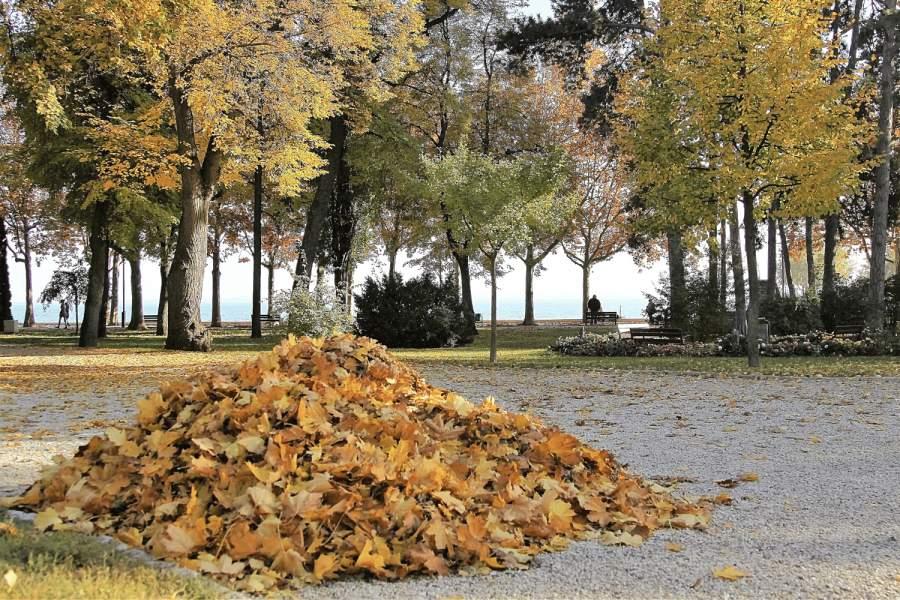You already know that leaves are an excellent addition to your compost pile. What’s more tricky is the actual collection (urgh!) and preparation of the leaves before they can be used in your compost pile or as mulch.
In this article, I cover:
- How to collect the leaves in the first place (think leaf blowers, lawnmowers, the trusty ol’ rake, etc)
- How to store leaves (what to use, best practices, DIY leaf bin options)
- Other uses for excess leaves (did you know that leaves are an excellent insulator for your compost pile?)
Let’s jump right in.
How to store leaves
Leaves… a nuisance for some but gold dust for others.
They’re one of the most useful things in our gardens, but the majority of people throw them away. Only the clever ones (you and me) keep them to help nourish our gardens in the summer.
But what’s the best way to store them?
You’ve probably already worked out that a simple pile isn’t going to cut it. You need something better.
A dedicated leaf bin
The best way to store leaves is in a dedicated leaf bin.
The bin can be anything really, as long as it’s big enough. An old garbage can could work well, but chances are you’d need several of them to hold all your leaves!
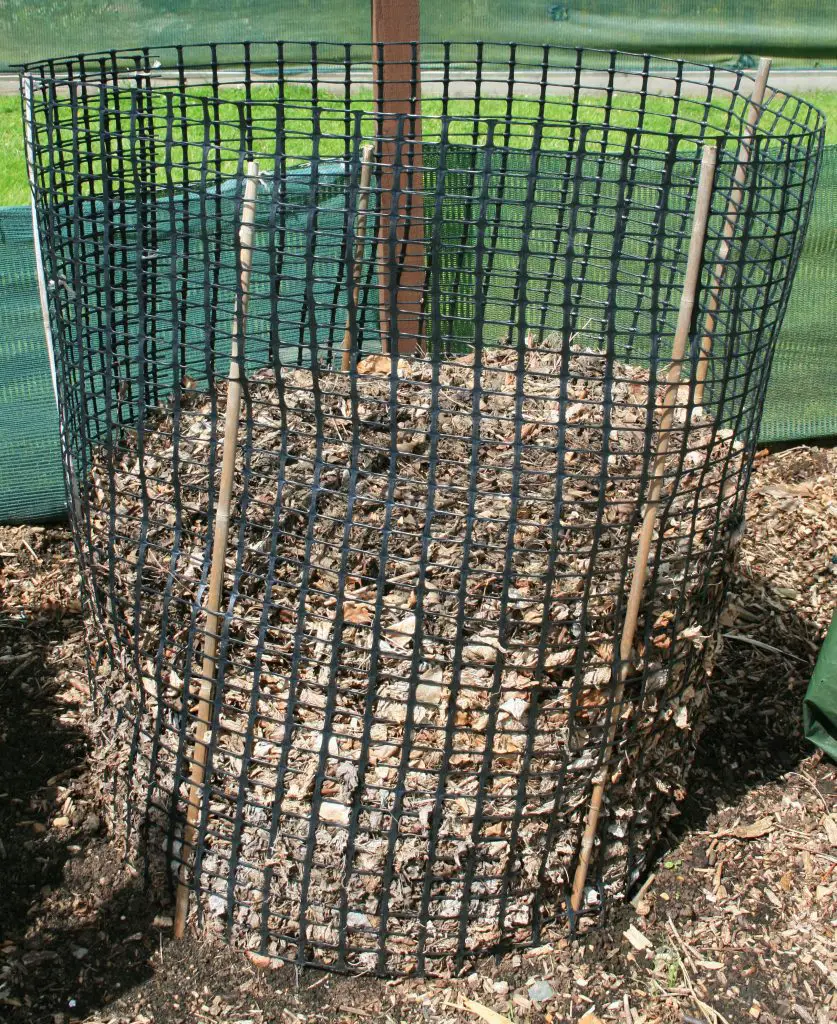
A simple and cheap DIY option is to get some wire or plastic mesh and create a bin with it using wooden stakes. The mesh will hold the leaves in place and keep them compacted.

Or you can get this ready-made bin from Geobin. It’s a big piece of sturdy plastic that you shape into a cylindrical bin. It’s really good for storing leaves because it’s adjustable, so you can make it bigger and smaller as you need.
For something more solid, check out this MTB wire bin. Just be aware that the mesh holes are on the larger side, so might allow some spillage if you’ve shredded your leaves.
Once you’ve got your bin, collect all your leaves (more on how to do that quickly later) and put them in the bin.
It’s that simple!
I recommend covering the bin mainly to prevent the leaves from blowing away. But, it can also come in handy for keeping rain out of the bin. This isn’t so much of a concern for compost, but if you’re going to use your leaves for mulch you want to keep them pretty dry.
The cover doesn’t have to be fancy. A weighted piece of tarp will do.
Also, try and place your bin near your compost pile or where you want to mulch. This will make it easy to grab a handful of leaves and use them as and when you need them.
Don’t worry if your bin fills up too quickly, the leaves will soon compact and make more room.
Want to learn more about leaf composters? Check out my review of the best leaf composters here.
Garbage bags
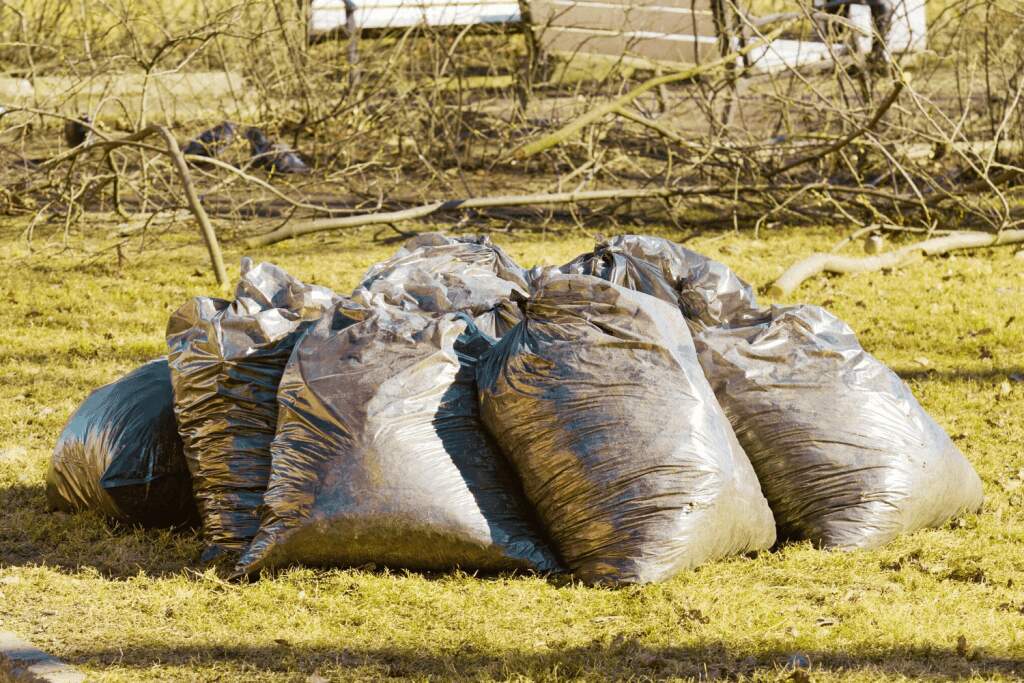
Another option is to keep your leaves contained in bags.
This method is good if you have an immediate need and can’t wait for a bin, but a bin is a better long-term solution.
Take your leaves and stuff them in your garbage bags.
Try to stuff as many leaves as you can in because they’ll decrease in volume pretty quickly. Don’t worry if the bag tears a little.
Once the bag is full, slash a few holes into the bag to allow airflow and tie them up. You can keep the bags inside or outside – wherever you have space is good.
I don’t recommend this method for long term storage for two reasons:
- I’d rather not use plastic bags when there’s a more sustainable alternative
- It’s more convenient to have all the leaves in one place rather than in several different bins bags
What happens to leaves in storage?
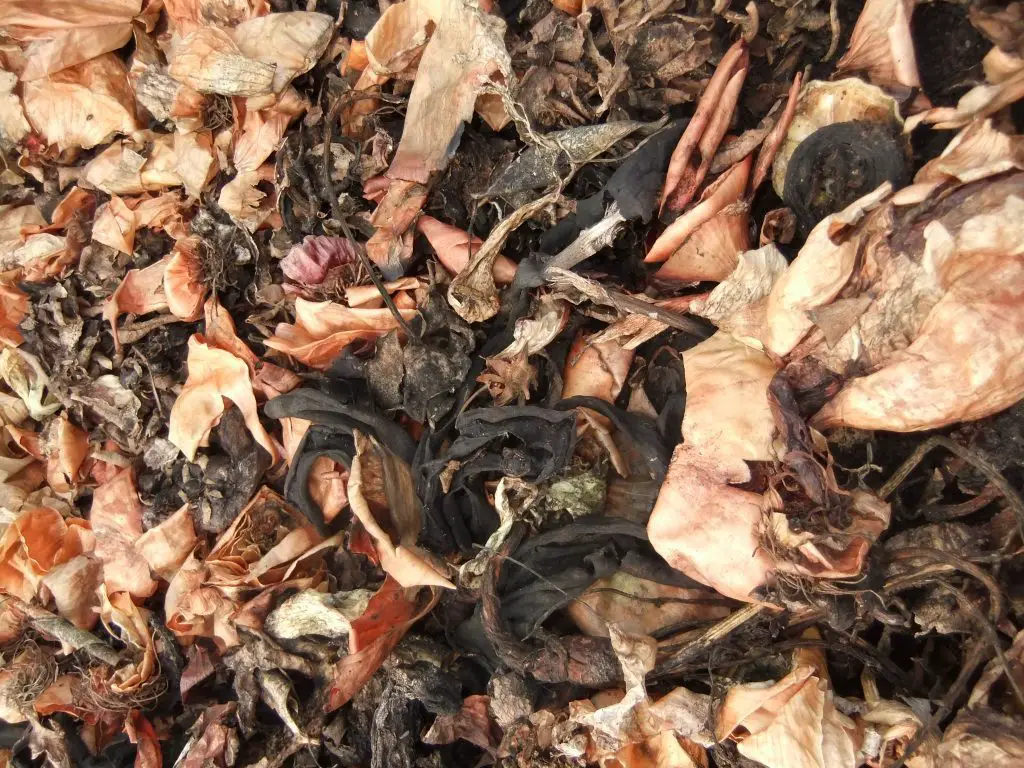
Leaves are organic matter, so unsurprisingly, when left to their own devices they’ll start to break down.
However, because they’re so high in carbon, the decomposition process is extremely slow. In some cases, it could take a couple of years for a pile of leaves to completely break down.
If you’re stashing fall leaves away with the intention to use them in the summer, there might be a bit of decomposition but not too much. If you mix some lawn clippings in with your leaves, the decomposition will be faster because the nitrogen from the grass will speed it up.
The type of leaves you’re using, the moisture levels, and the temperature will also have an effect on how much your leaves break down.
More moisture and higher temperatures = faster decomposition.
Tips if you’re storing leaves for compost
If you’re planning to use the leaves in your compost pile, some decomposition is a good thing.
The composting leaves will be teeming with beneficial microbes that will boost your pile. And the leaves will break down quicker than normal.
However, be aware that if you want to use the leaves to soak up excess moisture in the compost, you don’t want them to be too far along in the composting process.
You need dryish leaves for that job.
Remember that the leaves on the outside of your leaf pile will likely be less composted than those in the middle, so they’re the best ones to use in a wet compost pile.
Always shred the leaves before adding them to a compost pile. They’ll break down much faster and there’s less chance of the leaves sticking together and creating an oxygen/water barrier.
Tips if you’re storing leaves for mulch
If you plan to use the leaves for mulch you want to avoid too much decomposition.
Leaves are useful mulch because they suppress weeds. Composted leaves will do the opposite and encourage weed growth. Also, the more decomposed the leaves are, the less time they’ll be effective as mulch. You could find yourself needing to replace them pretty quickly.
To prevent your leaves from composting before you can use them, keep them dry. Moisture will encourage decomposition.
Also, try to avoid adding any sources of nitrogen into your leaf pile. Lawn clippings will be the most likely culprit here if you’re collecting leaves from your lawn.
A few strands will be okay, but too much nitrogen will speed up the composting process. Green leaves are also considered a source of nitrogen. Aim to keep the pile limited to dead leaves.
Just like with compost, you want to shred your leaves before using them as mulch.
Whole leaves can matt together and create a layer that water can’t penetrate. Shredded leaves are much less likely to matt and will make it easier for water to seep through.
How to collect leaves
Never try and collect wet leaves, it’s more hassle than it’s worth.
Wait for the leaves to dry out a bit before attempting to collect them. And collect in the same direction as the wind, trying to work against the wind will end up with leaves blowing everywhere.
For best results, use a combination of the below methods.
Use a lawnmower
The quickest way to collect leaves is with a lawnmower and a bag attachment.
First, set your mower to its highest setting so it doesn’t cut the grass.
Then roll the lawnmower over the leaves. It will suck the leaves up, shred them and collect them in the bag. A mulching lawnmower will work best because it’ll shred the leaves with ease.
If you have a lot of leaves, the lawnmower bag will fill up quite quickly so make sure you have containers for the leaves ready.
A lawnmower is a good option for really big yards because it is the least strenuous method. Certain mowers even come with a big leaf collection bag so you don’t need to change it as often.
Use a leaf blower / vacuum
A leaf blower is a handy tool that helps you blow the leaves into piles.
They’re great for medium-sized yards but can get heavy to hold after a while (unless you have a backpack leaf blower).
This cordless leaf blower & vacuum is a complete game-changer if you have a lot of leaves to round up.
It can take a little bit of time to find your rhythm with a leaf blower, but once you get the hang of it it’s quick and easy to use.
I advise blowing the leaves into lots of smaller piles. There’s nothing more demotivating than accidentally aiming the blower at a huge leaf pile you’ve built and it flying everywhere.
Once the leaves are in piles you can switch the machine to vacuum mode and suck the leaves up into the bag.

If your leaf blower doesn’t have a vacuum mode you can either blow the leaves onto a piece of tarp and use that to transport them, or pick the leaves up with a leaf scoop.
A leaf scoop is basically a massive pair of hands perfectly engineered to pick up a small pile of leaves.
Use a rake
A rake is the most traditional method for raking up leaves and works well for small yards where a leaf blower would be overkill.
But, if you have a big yard, a rake on its own is going to be hard work.
It’s important to get the right rake for the job. You can go for plastic or metal, but I recommend metal. A metal rake allows for deeper and more precise rakes. With plastic, yo’ll probably have to go over the same spots multiple times.

This rake from Gardenite fits the bill. Plus it has an adjustable head so you can thin the rake head to reach hard-to-get-to areas.
To make things easier, rake the leaves onto a piece of tarp or something similar. This will allow you to pick all the leaves up in one go and transfer them to whatever container you want.
Another option is to use a leaf scoop (giant hands).
Hire a professional
Decided you can’t be bothered? Or don’t have time?
There are people out there that would jump at the chance to come and collect the leaves from your lawn.
Check the internet for your local leaf collector and see what’s on offer.
What can you use leaves for?
Once you’ve got all your leaves collected you might be wondering what the best use for them all is. Compost and mulch are the most common use cases, but there are other options.
If you have more leaves than you bargained for, making some leaf mold or using them for insulation could solve your problem.
Using leaves in compost
A common use for autumn leaves is to add them to your garden compost pile.
They’re a great source of carbon, will soak up excess moisture, and can help add structure to your pile. Dried leaves will ‘fluff’ your compost up and improve airflow.
When you add the leaves to your compost make sure not to add them in one big clump. Instead, spread a thin layer. This will stop the leaves from matting together. Matted leaves can stop oxygen and water reaching the compost below, which can have significant consequences.
Shredding your leaves also helps to reduce matting and increases the speed of decomposition.
Using leaves as mulch
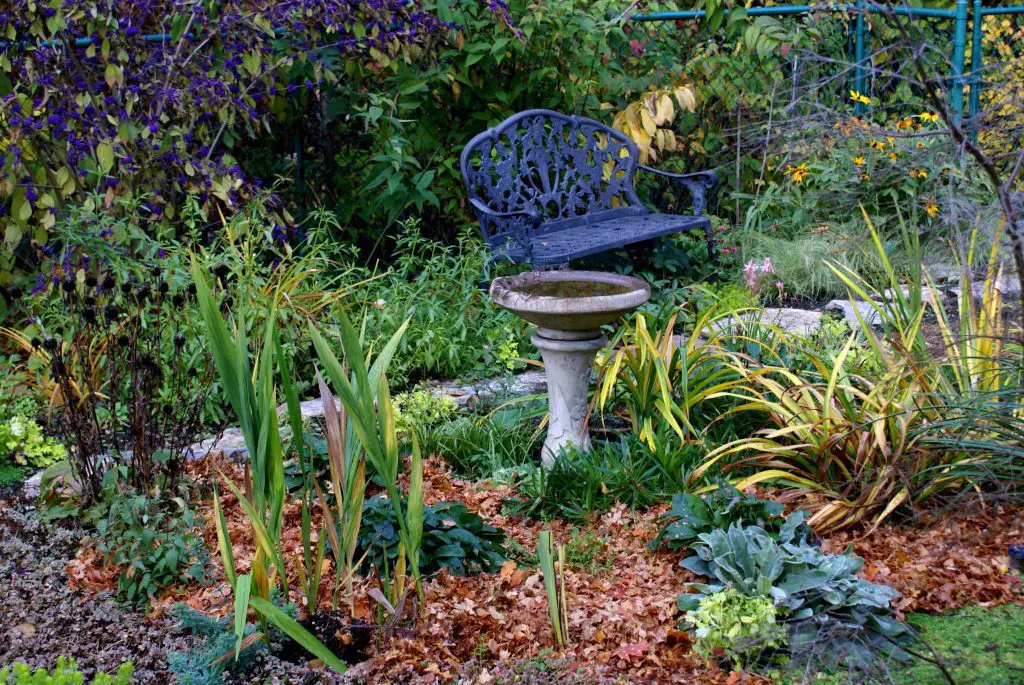
Dry leaves make an awesome, free mulch.
Mulch is used to cover the soil around you plants (or in your vegetable gardens) and protect it.
Using leaves as mulch has several benefits:
- Regulates soil temperature keeping it cool in the summer and warm in the winter
- Improves water retention and reduces the need for irrigation
- Suppresses weed growth by depriving the seeds of sunlight
- Gradually improves soil fertility and structure as it decomposes
One downside to leaf mulch is that it doesn’t look the best, and it can get easily blown away after a particularly windy day.
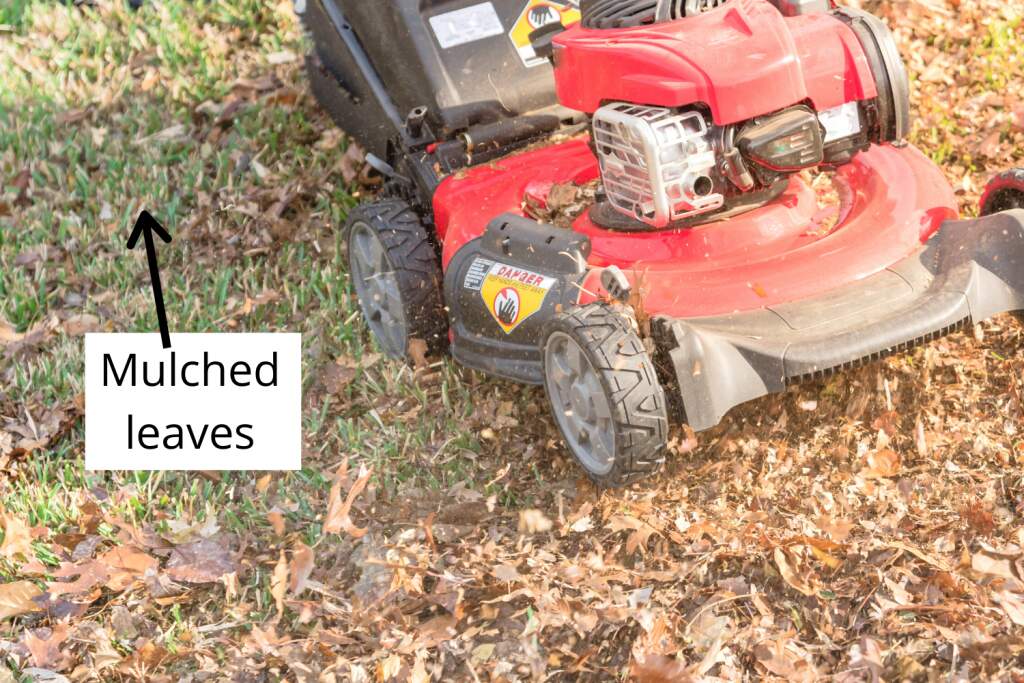
You can also ‘mulch’ your lawn by running all the leaves over with your lawnmower but not bagging them. The shredded leaves will quickly move to the bottom layer of the grass where they’ll break down and release their nutrients into the soil.
Using leaves as a soil amendment
If you want to use the leaves straight away you can dig them right into your soil.
Whether you’re building a new bed or preparing one for next year, mix some shredded leaves into the top few inches of the soil.
Over the next few months they’ll break down and attract a bunch of earthworms and beneficial organisms into the soil. When they’re finished, you should be able to notice an improvement in the soil structure.
In order to prevent the decomposing leaves ‘tieing up’ all the available nitrogen as they compost, you can add in some slow-release nitrogen fertilizer (or some coffee grounds!).
Using leaves as insulation for your compost pile
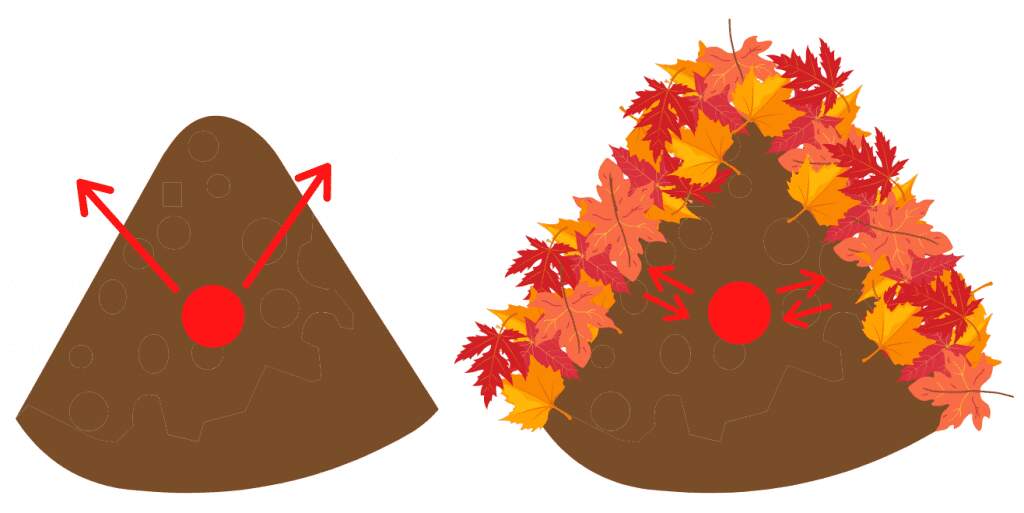
Leaves are free, abundant and make for a great insulator.
Covering your compost pile with a layer of dry leaves will help keep heat in and therefore keep the composting process ticking over, even when the outside temperature drops.
The leaves will eventually start to break down and become less efficient insulators. At this point you can incorporate them into the pile and add a new layer of leaves.
The perfect use for excess leaves.
Make leaf mold
Leaf mold is the name for compost made entirely from leaves. It’s not as nutritious as normal compost, but it is really good at improving soil structure. Most people think of it as a soil conditioner rather than a fertilizer.
Adding leaf mold to the soil will increase its water retention and give it a lighter, more porous texture (making it easier for roots to grow).
Making leaf mold is really easy:
- Pile the leaves up.
- Shred them (optional but highly recommended).
- Put the leaves in a bin or a bag and water them. Make sure the container has holes so air can flow and critters can find their way in.
- Wait for 12-18 months. Keep the leaves moist and turn the compost every month or so (turning is optional).
Instead of using your fall leaves in the summer as mulch or compost, you wait a bit longer.
By the next summer, you should have a black, crumbly soil amendment where your leaves used to be. The leaf mold should smell like a forest floor – that’s how you know it’s done.
To speed up the process you can add a nitrogen source to the leaves – grass clippings or coffee grounds work well.
Once you have the leaf mold you can dig it into your soil or you can use it as a top dressing or mulch. Leaf mold also makes a great addition to a potting mix because of its water retention ability.
